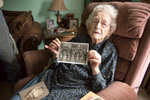
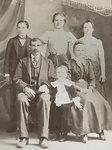
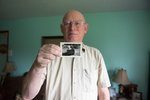
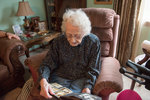
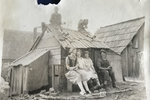
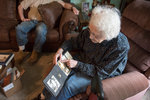
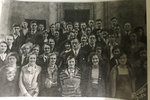
Just about 100 years ago, a 3-year-old Gladys Marrow was traveling with her family to Cinebar.
Gladys Frase, now 104 and using her married name, lives in a home with aquamarine walls and wood trim. Her photo albums hold pictures nearly 100 years old and dozens of loose photos are strewn across the coffee table. A black cat named Ebenezer can be heard meowing in the other room.
Frase has spent her morning collecting photos from her days at the Cinebar School. She uses a walker, but doesn’t hesitate to grab another photo from the next room, or old letters that she wants to share. Her memory is sharp and she names not only every person in her photos, but who they married, their parents, their family history and how their careers turned out.
She picks up a black and white photo of six children sitting on or near a small, rude structure that looks like a shed. It’s a play shed that one of the boys in the photo built.
“That’s a real precious picture,” said Gladys Frase, naming each person.
Frase is on the bench with her two sisters, Margaret and Elizabeth, and the eighth-grade boy who built the shed, Frank Thayer, is sitting at the end of the bench. In 1947, he became the Lewis County sheriff. Her brother, George, and Frank’s brother, Roy, are sitting on the roof.
“I’m sitting there next to Frank, but I didn’t like to sit near him,” Frase said.
When asked why, she pauses slightly, tilts her head forward and raises her eyebrows.
“He’s a boy,” she said. “I sat as far away as I could.”
For most of her life, Frase has lived in Onalaska. Frase, then Marrow — was born Oct. 20, 1914, to an Irish father and an English mother in Seattle.
In 1918, when she was 3 1/2 years old, her family moved to Cinebar. She attended the Cinebar School until eighth grade, then went to high school in Onalaska.
Frase — who will celebrate her 105th birthday this October — is a bit hard of hearing, but that doesn’t stop her from telling stories. This particular afternoon, she wants to talk about the trek to Cinebar and her early days in school. She’s spent an entire morning gathering those photos.
In 1918, Frase’s father purchased a home in Cinebar from a real estate broker. He paid board for her mother and siblings to stay with a woman in Seattle for the week. Then he took a wagon south to set up their new home.
When the week was up, Frase’s mother and siblings headed to Onalaska in a Model T Ford to meet her father. From Onalaska to Cinebar, the family took a wagon. The roads were too rough for a car.
“It was just a gravel road to Seattle,” she said. “I don’t remember anything beyond that about the trip down, except that I hung onto my Easter basket the whole way. … It was purple and yellow and Dad met us at Onalaska. He moved everything with a team of horses and a wagon. … He made it in three days from Seattle to Cinebar.”
All their possessions were in the wagon. When they first arrived in Cinebar, she said, people were still delivering mail by horseback for a short time.
“When we got up to Alpha, he stopped to get some groceries and when we started up, the wagon gave a lurch and it knocked that basket out of my hands,” she said. “He wouldn’t pick it up. He couldn’t fool around too much, because there was no electricity (at the Cinebar house) and when you got there you had to light a kerosene lamp. … We had had electricity in Seattle — we had a furnace, we had furnace heat — … and we moved to this big box, because that’s really what it was pretty much — a big box.”
Frase said that when she arrived, her mother said she crossed her arms and said, “I want to go home. This house is so cold and so dirty. I want to go home.”
Her father fixed up the house, though, and the family stayed. When she turned 5, Frase started school.
“I had brand-new shoes, galoshes and stuff — it was raining — and a new umbrella and everything new,” she said. “And I stepped in every mud puddle along the way. I remember that teacher, I remember when the boys took him down and took his shoes off to see if he had any holes in his socks.”
In 1940, Gladys Marrow married her late husband, Gene Frase, and took his name. The two moved into a home on the Frase Homestead and had two sons.
Gene Frase’s grandparents — Julius and Rosa Frase — homesteaded in 1889, just before Washington’s statehood. Today, the Frase property in Onalaska consists of the original 160 acres, and an additional 28 acres that Gladys Frase bought from the Carlisle Lumber Company.
One of her sons, Steve Frase, also lives on the original homestead property and often stops in to visit his mother. He has lived on the property for the majority of his life, and he is the fourth generation to live there.
“These would be my great- grandparents,” said Steve Frase, pointing to a photo of Julius and Rosa Franks.
Steve Frase was born after Julius died, but his grandfather, Carl Frase, mentioned that Julius worked with members of the Newaukum Indian Tribe on a farm.
“It was pretty vague,” Steve Frase said. “There was talk about raising hops.”
Steve Frase was active in the Navy for four and a half years and did two tours in Vietnam. He graduated from University of Washington and worked for Longview Fiber from 1974 until 1991. After that, he moved back to the Frase Homestead.
“One time on the homestead, they had over 100 fruit trees,” Steve Frase said. “I remember when I was a kid, they had a Columbus Day storm in ‘62, knocked a lot of our trees down. We had a real big orchard up the hill there. There are still a few left that are getting pretty old. … They had a blacksmith shop, chicken house, brooder house, pig house, the barn, smoke house, a big wood shed … That’s when I was a kid growing up.”
Those buildings aren’t there anymore.
“It’s kind of amazing you know,” Steve Frase said. “Timewise, you look at all the changes that have happened, even in Mom’s lifespan. Her dad used to plow with a horse, walk behind and plow. Then when Dad got his first tractor out in the barn … he plowed the fields in just a few hours, which would take several days with a horse plow — there has been so much change.”